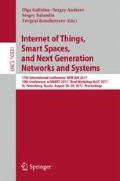Abstract
Domain Name System (DNS) plays an important role as a translation protocol in everyday use of the Internet. The purpose of DNS is to translate domain names into IP addresses and vice versa. However, its simple architecture can easily be misused for malicious activities. One huge security threat concerning DNS is tunneling, which helps attackers bypass the security systems unnoticed. A DNS tunnel can be used for three purposes: as a command and control channel, for data exfiltration or even for tunneling another protocol through it. In this paper, we surveyed different techniques for DNS tunneling detection. We classified those first based on the type of data and then within the categories based on the type of analysis. We conclude with a comparison between the various detection techniques. We introduce one real Advanced Persistent Threat campaign that utilizes DNS tunneling, and theoretically compare how well the surveyed detection techniques could detect it.
Access this chapter
Tax calculation will be finalised at checkout
Purchases are for personal use only
References
Farnham, G., Atlasis, A.: Detecting DNS tunneling. SANS Institute InfoSec Reading Room, pp. 1–32 (2013)
Ellens, W., Żuraniewski, P., Sperotto, A., Schotanus, H., Mandjes, M., Meeuwissen, E.: Flow-based detection of DNS tunnels. In: Doyen, G., Waldburger, M., Čeleda, P., Sperotto, A., Stiller, B. (eds.) AIMS 2013. LNCS, vol. 7943, pp. 124–135. Springer, Heidelberg (2013). doi:10.1007/978-3-642-38998-6_16
Evasive Maneuvers by the Wekby group with custom ROP-packing and DNS covert channels. https://www.anomali.com/blog/evasive-maneuvers-the-wekby-group-attempts-to-evade-analysis-via-custom-rop
New Wekby attacks use DNS requests as command and control mechanism (2016). http://researchcenter.paloaltonetworks.com/2016/05/unit42-new-wekby-attacks-use-dns-requests-as-command-and-control-mechanism/
Chinese cyber espionage APT group leveraging recently leaked hacking team exploits to target a financial services firm. https://www.zscaler.com/blogs/research/chinese-cyber-espionage-apt-group-leveraging-recently-leaked-hacking-team-exploits-target-financial-services-firm
Karasaridis, A., Meier-Hellstern, K., Hoeflin, D.: NIS04-2: detection of DNS anomalies using flow data analysis. In: IEEE Global Telecommunications Conference, GLOBECOM 2006, pp. 1–6 (2006)
Copeland III, J.A.: Flow-based detection of network intrusions (2007). http://www.google.com/patents/US7185368
Brodsky, E., Darkhovsky, B.S.: Nonparametric Methods in Change Point Problems. Springer Science & Business Media, Heidelberg (2013)
Marchal, S., François, J., Wagner, C., State, R., Dulaunoy, A., Engel, T., Festor, O.: DNSSM: a large scale passive DNS security monitoring framework. In: 2012 IEEE Network Operations and Management Symposium (NOMS), pp. 988–993. IEEE (2012)
Hartigan, J.A., Wong, M.A.: Algorithm AS 136: a K-means clustering algorithm. J. R. Stat. Soc. Ser. C Appl. Stat. 28, 100–108 (1979)
Aiello, M., Mongelli, M., Papaleo, G.: Basic classifiers for DNS tunneling detection. In: 2013 IEEE Symposium on Computers and Communications (ISCC), pp. 880–885 (2013)
Aiello, M., Mongelli, M., Papaleo, G.: DNS tunneling detection through statistical fingerprints of protocol messages and machine learning. Int. J. Commun. Syst. 28, 1987–2002 (2015)
HSC - Tools - Dns2tcp. http://www.hsc.fr/ressources/outils/dns2tcp/
Moore, A.W., Zuev, D.: Internet traffic classification using Bayesian analysis techniques. In: Proceedings of the 2005 ACM SIGMETRICS International Conference on Measurement and Modeling of Computer Systems, pp. 50–60. ACM, New York (2005)
Cover, T., Hart, P.: Nearest neighbor pattern classification. IEEE Trans. Inf. Theory 13, 21–27 (1967)
Ripley, B.D.: Pattern Recognition and Neural Networks. Cambridge University Press, Cambridge (2007)
Cortes, C., Vapnik, V.: Support-vector networks. Mach. Learn. 20, 273–297 (1995)
Satam, P., Alipour, H., Al-Nashif, Y., Hariri, S.: Anomaly behavior analysis of DNS protocol. J. Internet Serv. Inf. Secur. JISIS 5, 85–97 (2015)
Breiman, L.: Bagging predictors. Mach. Learn. 24, 123–140 (1996)
Bramer, M.: Principles of Data Mining. Springer, London (2007)
Born, K., Gustafson, D.: Detecting DNS tunnels using character frequency analysis (2010). arXiv:1004.4358[cs]
Born, K., Gustafson, D.: NgViz: detecting DNS tunnels through n-gram visualization and quantitative analysis. In: Proceedings of the Sixth Annual Workshop on Cyber Security and Information Intelligence Research, pp. 47:1–47:4. ACM, New York (2010)
Zipf, G.K.: Selected Studies of the Principle of Relative Frequencies of Language. Harvard University, Cambridge (1932)
kryo.se: iodine (IP-over-DNS, IPv4 over DNS tunnel). http://code.kryo.se/iodine/
TCP-over-DNS tunnel software HOWTO. http://analogbit.com/2008/07/27/tcp-over-dns-tunnel-software-howto/
Qi, C., Chen, X., Xu, C., Shi, J., Liu, P.: A bigram based real time DNS tunnel detection approach. Procedia Comput. Sci. 17, 852–860 (2013)
Binsalleeh, H., Kara, A.M., Youssef, A., Debbabi, M.: Characterization of covert channels in DNS. In: 2014 6th International Conference on New Technologies, Mobility and Security (NTMS), pp. 1–5 (2014)
Kara, A.M., Binsalleeh, H., Mannan, M., Youssef, A., Debbabi, M.: Detection of malicious payload distribution channels in DNS. In: 2014 IEEE International Conference on Communications (ICC), pp. 853–858 (2014)
Cejka, T., Rosa, Z., Kubatova, H.: Stream-wise detection of surreptitious traffic over DNS. In: 2014 IEEE 19th International Workshop on Computer Aided Modeling and Design of Communication Links and Networks (CAMAD), pp. 300–304 (2014)
Author information
Authors and Affiliations
Corresponding author
Editor information
Editors and Affiliations
Rights and permissions
Copyright information
© 2017 Springer International Publishing AG
About this paper
Cite this paper
Nuojua, V., David, G., Hämäläinen, T. (2017). DNS Tunneling Detection Techniques – Classification, and Theoretical Comparison in Case of a Real APT Campaign. In: Galinina, O., Andreev, S., Balandin, S., Koucheryavy, Y. (eds) Internet of Things, Smart Spaces, and Next Generation Networks and Systems. ruSMART NsCC NEW2AN 2017 2017 2017. Lecture Notes in Computer Science(), vol 10531. Springer, Cham. https://doi.org/10.1007/978-3-319-67380-6_26
Download citation
DOI: https://doi.org/10.1007/978-3-319-67380-6_26
Published:
Publisher Name: Springer, Cham
Print ISBN: 978-3-319-67379-0
Online ISBN: 978-3-319-67380-6
eBook Packages: Computer ScienceComputer Science (R0)

